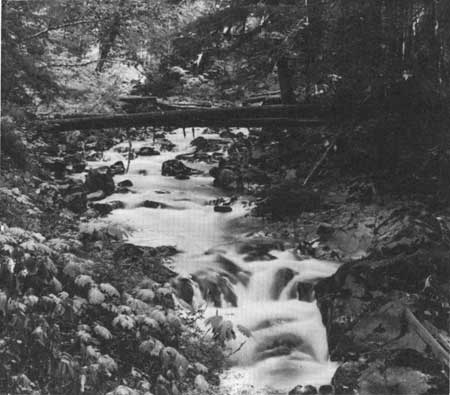|
OLYMPIC National Park |
 |
Climate and the Water Cycle
Of all inorganic substances, acting in their own proper nature, and without assistance or combination, water is the most wonderful. If we think of it as the source of all the changefulness and beauty which we have seen in clouds; then as the instrument by which the earth we have contemplated was modeled into symmetry, and its crags chiseled into grace; then as, in the form of snow, it robes the mountains it has made, with that transcendent light which we could not have conceived if we had not seen; then as it exists in the foam of the torrent—in the iris which spans it, in the morning mist which rises from it, in the deep crystalline pools which mirror its hanging shore, in the broad lake and glancing river; finally, in that which is to all human minds the best emblem of unwearied, unconquerable power, the wild, various, fantastic, tameless unity of the sea; what shall we compare to this mighty, this universal element, for glory and for beauty? or how shall we follow its eternal changefulness of feeling? It is like trying to paint a soul.—Ruskin
The earth's supply of water is fixed—it is used over and over again. What falls on land as rain or snow runs off, evaporates, or sinks into the ground. That which sinks into the ground may return: (1) to the air, by transpiration from plants and by evaporation from soil; and (2) to the sea, as ground water either flowing into streams or directly into the sea. All water falling upon the land eventually returns to the sea or to lakes whence it came. It evaporates and precipitates again and again. This continuous round of moisture is known as the hydrologic, or water, cycle. It is impressively demonstrated in the Olympics.
Salt water borders the Olympic Peninsula on three sides. Lowland on the south completes the isolation of the mountains. From atop some mountain peaks one can see the Olympic water cycle in its entirety—ocean, "cloudscape," snowfields, glaciers, streams from source to mouth returning water to the sea, and forests transpiring moisture into the air.
 ANDERSON GLACIER NESTLES ON THE FLANK OF MOUNT ANDERSON, ONE OF SEVERAL HIGH AND RUGGED PEAKS ON THE PARK'S EASTERN EDGE. |
A landscape is an expression of climate. The Olympic landscape, with its rain forests, snowfields, glaciers, lakes, and numerous streams in deep valleys, is a superb expression of a superhumid climate. Abundant water is the prime source of Olympic's character. The prevailing on-shore winds acquire much moisture in passing over the ocean. The windward slopes of the Olympics cause this nearly saturated ocean air to rise. Consequently, the western slopes of the Olympic Mountains receive the greatest precipitation in the conterminous United States.
The Hoh Ranger Station has a mean annual precipitation of 142 inches, with 174.6 inches recorded in 1961. Precipitation on Mount Olympus recorded in 1958 was 149 inches but this same year only 130 inches were received at the Hoh. Scientists who have been studying Blue Glacier on Mount Olympus since 1957 believe the heads of the western valleys receive 200 inches in some years.
Marine climates have greater precipitation in winter than in summer. Seventy-six percent of the yearly precipitation in northwest Washington occurs during the 6 months between October 1 and March 31. There is no definite time for the beginning and ending of the "dry" and "rainy" seasons, as the transition is gradual and variable.
The Olympic Peninsula would be well watered even if there were no mountains. The mountains, however, are responsible for wringing the bulk of the moisture from the saturated clouds and for creating local variations in the amount of precipitation. After passing over the mountains, the air is warmed in descending the leeward slopes. Consequently, the lowland areas on the lee side of the mountains are much drier than on the windward side. For instance, on the Olympic Peninsula at Sequim (pronounced Squim) the mean annual precipitation is less than 17 inches, and irrigation is required for successful agriculture.
Another prominent characteristic of the climate is the mildness of the winters at low elevations. In fact, western Washington is milder in winter than any other section of the continent in the same latitude. The reasons for this are the warming influence of the ocean and the protecting influence of the Cascade Mountains and of the Rocky Mountains against the flow of cold continental air westward to the coast.
Storm centers that pass eastward across Washington in winter shift to the north in summer, resulting in sunny summer weather that is delightfully cool under the influence of the ocean.
 THE SOLEDUCK RIVER RUSHES THROUGH THE DEEP FOREST. |

|

|
|
|
|
Last Modified: Sat, Nov 4 2006 10:00:00 pm PST |


